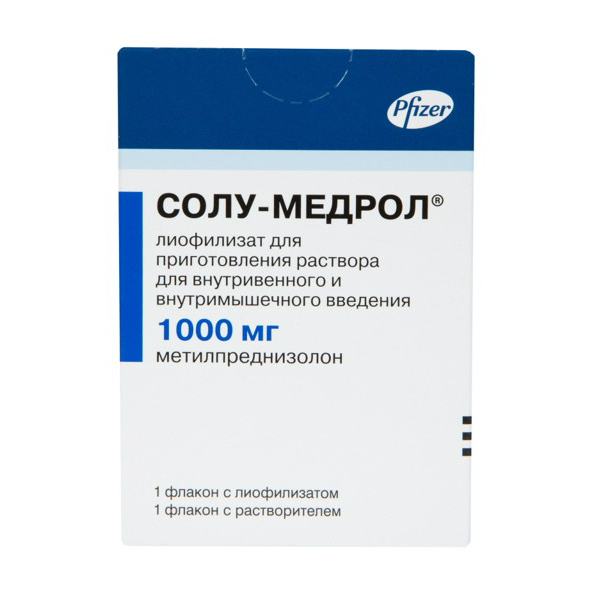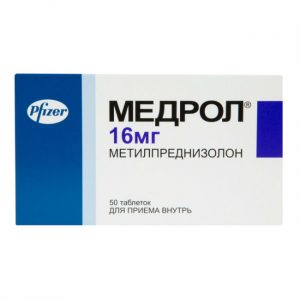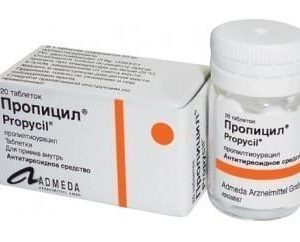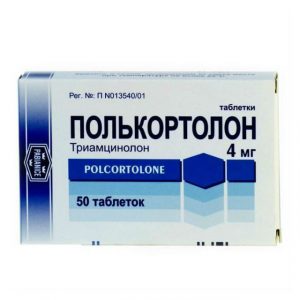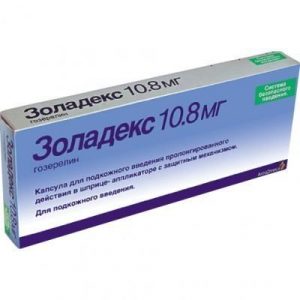Description
Latin name
Solu-Medrol
Release form
Powder for preparation of solution
Packaging
In a solvent bottle 1000 mg of lyophilisate. In a pack of cardboard 1 bottle.
Pharmacological action of
Solu-Medrol – GCS penetrate cell membranes and form complexes with specific cytoplasmic receptors. Then these complexes penetrate the cell nucleus, bind to DNA (chromatin) and stimulate the transcription of mRNA and the subsequent synthesis of various enzymes, which explains the effect of corticosteroids during systemic use. GCS not only have a significant effect on the inflammatory process and the immune response, but also affect carbohydrate, protein and fat metabolism. Most indications for the use of GCS are due to their anti-inflammatory, immunosuppressive and anti-allergic properties. Thanks to these properties, the following therapeutic effects are achieved:
A decrease in the number of immunoactive cells near the site of inflammation.
Reduced vasodilation.
Stabilization of lysosomal membranes.
Inhibition of phagocytosis.
Reduced production of prostaglandins and related compounds. Methylprednisolone has a strong anti-inflammatory effect, moreover, its activity exceeds that of prednisolone, and the ability to cause water and sodium ion retention is reduced compared to prednisolone.
Metabolism and the anti-inflammatory mechanism of methylprednisolone sodium succinate are similar to those for methylprednisolone. With parenteral administration of equivalent amounts, the biological activity of both compounds is the same. With iv administration, the ratio of the activities of methylprednisolone sodium succinate and hydrocortisone sodium succinate, calculated by reducing the number of eosinophils, is at least 4: 1. This correlates well with the relative oral methylprednisolone and hydrocortisone activity. A dose of 4 mg methylprednisolone has the same glucocorticosteroid (anti-inflammatory) effect as 20 mg of hydrocortisone. Methylprednisolone has only negligible mineralocorticoid activity (200 mg of methylprednisolone is equivalent to 1 mg of deoxycorticosterone).
The maximum pharmacological activity of corticosteroids is not manifested at the peak concentration in plasma, but after it, therefore, the action of corticosteroids is due primarily to their effect on the activity of enzymes.
Indications
Endocrine diseases
primary and secondary adrenal insufficiency (if necessary in combination with mineralocorticosteroids, especially in pediatric practice)
acute adrenal insufficiency (there may be a need for addition of mineralocorticosteroids in acute symptomatic therapy, when adrenal insufficiency is possible (if mineralocorticosteroid action undesirable)
in the preoperative period, in case of severe injury or serious illness, in patients with established or suspected adrenal insufficiency
congenital adrenal hyperplasia
subacute thyroiditis
hypercalcemia due to cancer.
Rheumatic diseases (as an additional treatment for short-term relief from an acute condition or during an exacerbation)
post-traumatic osteoarthritis
synovitis with osteoarthritis
rheumatoid arthritis, including juvenile rheumatoid arthritis (in some cases, acute low-dose therapy is required) epicondylitis.
acute nonspecific tendosynovitis
acute gouty arthritis
psoriatic arthritis
ankylosing spondylitis.
Systemic diseases of the connective tissue (during an exacerbation or in some cases as maintenance therapy)
systemic lupus erythematosus (and lupus nephritis)
acute rheumatic carditis
systemic dermatomyositis (polymyositis)
nodular periarteritis
syndrome Good.
Skin diseases
pemphigus
severe erythema multiforme (Stevens-Johnson syndrome)
exfoliative dermatitis
severe psoriasis
herpetiform bullous dermatitis
severe seborrheic dermatitis
fungal mycosis.
Allergic conditions (in case of severe or disabling conditions, in which conventional therapy is ineffective)
bronchial asthma
contact dermatitis
atopic dermatitis
serum disease
seasonal or perennial allergic rhinitis
drug hypersensitivity reactions
post-transfusion urticaria
Eye diseases (severe acute and chronic allergic and inflammatory processes with eye damage)
ophthalmic form Herpes zoster
iritis and iridocyclitis
chorioretinitis
diffuse posterior uveitis and choroiditis
neuritis sverdkrrdlrd srdlkrdrdrd corneal ulcers
keratitis.
Diseases of the gastrointestinal tract (for removing a patient from a critical condition)
ulcerative colitis
regional enteritis.
Respiratory tract disease
symptomatic sarcoidosis
berylliosis
fulminant and disseminated pulmonary tuberculosis in combination with appropriate anti-tuberculosis chemotherapy
Leffler’s syndrome, not amenable to therapy with other means of
aspiration pneumonitis.
Hematologic diseases
acquired (autoimmune) hemolytic anemia
idiopathic thrombocytopenic purpura in adults (only intravenous i / m administration is contraindicated)
secondary thrombocytopenia in adults
erythroblastopenemia erythroblastopenemia erythroblastopenemia (erythroblastopenemia (erythroblastopenemia) erythroblastopenemia (erythroblastopenemia
Oncological diseases (as palliative therapy)
leukemia and lymphoma in adults
acute leukemia in children
to improve the quality of life of patients with cancer in the terminal stage.
Edematous
syndrome to stimulate diuresis and achieve remission of proteinuria in patients with nephrotic syndrome without uremia.
Nervous system
brain edema caused by a tumor – primary or metastatic, and / or associated with surgical or radiation therapy
exacerbation of multiple sclerosis
acute traumatic injuries of the spinal cord. Treatment should begin in the first 8 hours after the injury.
Other indications for use
tuberculous meningitis with subarachnoid block or block threat (in combination with appropriate anti-tuberculosis chemotherapy)
trichinosis with damage to the nervous system or myocardium
organ transplantation
prevention of nausea and vomiting related diseases.
Use in children
The use of the drug in children during the growth period is possible only according to absolute indications and with especially careful monitoring by the attending physician.
Contraindications
Systemic fungal infections.
Hypersensitivity to any component of the drug in history.
It is not recommended to use the drug in patients with acute and subacute myocardial infarction, since the use of glucocorticosteroids in them can lead to the spread of the focus of necrosis, slow the formation of scar tissue and, as a result, to rupture of the heart muscle.
Caution:
In patients with herpes simplex virus eye damage, as this may result in corneal perforation.
For ulcerative colitis, if there is a risk of perforation, abscess or other purulent infection.
For diverticulitis.
In the presence of fresh intestinal anastomoses.
With active or latent peptic ulcer.
Renal failure.
Arterial Hypertension.
Osteoporosis.
myasthenia gravis.
This medication contains gasoline alcohol. It has been established that gasoline alcohol can cause lethal suffocation syndrome in premature infants. The drug is not recommended for use in newborns.
Use in pregnancy and lactation
A number of animal studies have shown that administration of high doses of GCS to females can lead to malformations in the fetus. However, a number of clinical studies have shown that the use of corticosteroids during pregnancy, apparently, does not cause congenital malformations. In one retrospective study, there was an increase in the incidence of low birth weight infants in mothers who received GCS. Since studies on pregnant women do not exclude the possible harm of GCS, the use of these drugs during pregnancy, in nursing mothers or women of childbearing age requires an assessment of the likely positive effect of the drug in comparison with the potential risk to the mother, embryo or fetus. GCS should be prescribed during pregnancy only by absolute indications.
corticosteroids easily cross the placenta. Although in infants born to mothers who received significant doses of GCS during pregnancy, adrenal insufficiency is rare, such children should be carefully examined to identify possible symptoms of adrenal hypofunction. The effect of GCS on the course and outcome of labor is unknown.
GCS is excreted in breast milk, therefore, if it is necessary to prescribe the drug SOLU-MEDROL during breastfeeding, breast-feeding should be discontinued.
Composition
1 vial contains:
Active ingredient: methylprednisolone (as sodium succinate) 500 mg
Excipients: monobasic sodium phosphate monohydrate, sodium hydrogen phosphate.
Dosage and administration
Solu-medrol can be administered as an intravenous or intramuscular injection or as an intravenous infusion, but in case of emergency, treatment should preferably be started with an intravenous injection. Children should be given lower doses (but not less than 0.5 mg / kg / day), however, when choosing a dose, the severity of the condition and the patient’s response to therapy are taken into account first, and not age and body weight.
As an adjunctive therapy for life-threatening conditions,
30 mg / kg iv body weight for at least 30 minutes. The introduction of this dose can be repeated every 4-6 hours for a maximum of 48 hours.
Pulse therapy in the treatment of diseases in which corticosteroid therapy is effective, with exacerbations of the disease and / or with the failure of standard therapy.
Recommended regimens:
Rheumatic diseases: 1 g / day iv for 1 to 4 days or 1 g / month iv for 6 months.
Systemic lupus erythematosus: 1 g / day iv for 3 days.
Multiple sclerosis: 1 g / day iv for 3 or 5 days.
Edematous conditions, for example, glomerulonephritis, lupus nephritis: 30 mg / kg every other day for 4 days or 1 g / day iv for 3, 5 or 7 days
The above doses should be administered for at least 30 minutes, and administration can be repeated if no improvement is achieved within a week after treatment, or if the patient’s condition requires it.
Oncological diseases in the terminal stage – to improve the quality of life
125 mg / day iv daily for up to 8 weeks.
Prevention of nausea and vomiting associated with chemotherapy for cancer
During chemotherapy with drugs that have a mild or moderate vomiting effect, 250 mg iv are administered for at least 5 minutes one hour before the chemotherapeutic drug is administered, at the beginning of chemotherapy, as well as after its completion. To enhance the effect with the first dose of the drug Solu-medrol, chlorphenothiazine preparations can be administered.
During chemotherapy with drugs that have a pronounced emetic effect, 250 mg iv are administered for at least 5 minutes in combination with appropriate doses of metoclopramide or butyrophenone one hour before the chemotherapeutic drug is administered, then 250 mg iv at the beginning of chemotherapy and after her graduation.
Acute traumatic injury to the spinal cord
Treatment should be started in the first 8 hours after the injury. It is recommended that iv bolus is administered for 15 minutes 30 mg / kg body weight, then a 45-minute break is taken, and then a continuous infusion is carried out at a dose of 5.4 mg / kg / h for 23 hours (if treatment is started in the first 3 hours after injury) or 47 hours (if treatment is started in the first 3-8 hours after injury). The drug should be administered using an infusion pump into an isolated vein.
For other indications, the initial dose is 10-500 mg iv depending on the nature of the disease. For a short course in severe acute conditions, higher doses may be required. An initial dose not exceeding 250 mg should be administered iv for at least 5 minutes, doses over 250 mg should be administered for at least 30 minutes. Subsequent doses are administered intravenously or intramuscularly, and the duration of the intervals between administrations depends on the patient’s response to therapy and on his clinical condition.
Preparation of
solutions Preparations for parenteral administration should, if possible, be visually checked for discoloration or particle formation.
a) Act-0-Vial
two-bottle vial Press on the plastic activator so that the solvent overflows into the lower container.
Gently rock the bottle until until the lyophilisate dissolves.
Remove the plastic disc covering the center of the plug.
Treat the cork surface with an appropriate antiseptic.
Pierce the center of the plug with the needle so that the tip of the needle is visible. Turn the bottle over and take the required amount of solution with a syringe.
b) Bottle
Aseptically, introduce the solvent into the bottle with lyophilisate. Use only special solvent.
c) Preparation of solutions for intravenous infusion
Prepare the solution as described above. The drug can also be introduced in the form of diluted solutions obtained by mixing the initial solution of the drug with 5% aqueous dextrose solution, with physiological saline, with 5% dextrose solution in 0.45% or 0.9% sodium chloride solution. The prepared solutions are physically and chemically stable for 48 hours.
Side effects of
On the part of water-electrolyte metabolism: sodium retention, chronic heart failure in patients with an appropriate predisposition, fluid and salt retention in the body, increased excretion of potassium, hypokalemic alkalosis.
From the cardiovascular system: increase or decrease in blood pressure, cardiac arrhythmias (arrhythmias, bradycardia, tachycardia) chronic heart failure (in patients with predisposition) in patients with acute and subacute myocardial infarction – the spread of the focus of necrosis, slowing the formation of scar tissue, which can lead to rupture of the heart muscle. There are reports of cardiac arrhythmias and / or the development of circulatory collapse and / or cardiac arrest after rapid iv administration of high doses of methylprednisolone (more than 0.5 g administered for less than 10 minutes). During and after iv administration of high doses of methylprednisolone, cases of bradycardia were also noted, but they did not necessarily depend on the speed or duration of the infusion.
From the musculoskeletal system: osteonecrosis, myopathy, muscle weakness, osteoporosis, pathological fractures, muscle atrophy, neuropathic atrophy, arthralgia, myalgia, compression fractures of the vertebrae, aseptic necrosis of the epiphyses of the tubular bones, tendon ruptures, especially Acute myopathy most often develops when high doses of methylprednisolone are used in patients with impaired neuromuscular transmission (e.g. with myasthenia gravis), or in patients simultaneously receiving treatment with anticholinergics, such as peripheral muscle relaxants (for example, pancuronium bromide). Such acute myopathy is generalized in nature, can affect the muscles of the eye and respiratory system, leading to the development of tetraparesis. Possible increase in creatine kinase levels. In this case, improvement or recovery after the cancellation of methylprednisolone can occur only after many weeks or even after several years.
From the digestive system: peptic ulcer with possible perforation and bleeding, gastric bleeding, pancreatitis, peritonitis, esophagitis (including), perforation of the intestinal wall, abdominal pain, tension of the abdominal wall, diarrhea, dyspepsia, flatulence, nausea, vomiting, persistent hiccups.
After treatment with methylprednisolone, an increase in the activity of plasma alanine aminotransferase (ALT), aspartate aminotransferase (ACT), and alkaline phosphatase was observed. Typically, these changes are insignificant, not associated with any clinical syndromes, and are reversible after discontinuation of treatment.
From the skin: angioedema, peripheral edema, skin asrophy, skin stretch marks, petechiae and ecchymosis, decreased skin pigmentation, hirsutism, rash, erythema, skin itching, urticaria, acne, slow healing of wounds, reactions at the injection site.
From the side of metabolism: negative nitrogen balance (increased protein breakdown) caused by protein catabolism, growth retardation and ossification in children (premature closure of pineal gland growth zones), increased appetite (can lead to increased body weight), increased sweating.
From the nervous system: increased intracranial pressure with swelling of the optic nerve (benign intracranial hypertension), convulsions, amnesia, thinking disorders, dizziness, headache, affective disorders (including lability of mood, depressed mood, euphoria, psychological dependence, thinking), psychotic disorders (including mania, dyslusions, hallucinations, schizophrenia or its aggravation), confusion, mental disturbance, anxiety, personality change , Rapid mood changes, unusual behavior, insomnia, irritability.
From the endocrine system: menstrual irregularities, Itsenko-Cushing’s syndrome, hypopituitarism, the development of the syndrome of “cancellation” of steroid drugs, a decrease in glucose tolerance, increased demand for insulin or gioglyxmic drugs for oral administration in patients with diabetes mellitus, growth retardation in children, lipomatosis, latent diabetes mellitus.
Laboratory indicators: increased plasma urea concentration, dyslipidemia, increased urinary calcium concentration, hypocalcemia.
From the sensory organs: posterior subcapsular cataract, increased intraocular pressure, glaucoma, exophthalmos, vertigo, secondary fungal or viral ocular infection, perforation of the cornea (with ocular manifestations of herpes simplex).
On the part of the immune system: infectious diseases, the occurrence of infections caused by opportunistic pathogens, hypersensitivity reactions, including anaphylaxis with or without circulatory collapse, cardiac arrest, bronchospasm, suppression of reactions during skin tests.
Other: fatigue, weakness.
Drug Interaction
Compatibility and stability of solutions of sodium succinate methylprednisolone sodium when administered with / in other medicines included in mixtures for intravenous administration, depend on pH, concentration, time, temperature, and temperature.
SALT-MEDROL is recommended to be administered separately from other medicines, if possible, in the form of bolus injections, in / in a drip infusion, or through an additional dropper as a second solution.
The following drug interaction examples may have important clinical implications.
The combined use of methylprednisolone and cyclosporine causes mutual inhibition of metabolism, so it is likely that side effects, associated with the use of each of these drugs as monotherapy, when co-administered, may occur more often. With the joint use of these drugs were noted cases of convulsions. Drugs that activate liver enzymes, such as phenobarbital, phenytoin, and rifampicin, may increase the clearance of methylprednisolone, which may require increasing the dose of the drug to obtain the desired effect.
CYP3A4 inhibitors (such as macrolide antibiotics, azole antifungals, some calcium channel blockers) can suppress methylprednisolone metabolism and reduce its clearance. In this case, to avoid the effects of overdose, you should reduce the dose of methylprednisolone. Methylprednisolone can increase the clearance of acetylsalicylic acid, taken in high doses over a long period, which may lead to a decrease in serum salicylate levels or increase the risk of salicylate toxicity with methylprednisolone withdrawal. In patients with hypoprotrombinemia, acetylsalicylic acid in combination with ACS should be administered with caution. Methylprednisolone has a variety of effects on the action of oral anticoagulants. Both enhancement and reduction of the effect of anticoagulants taken with methylprednisolone have been reported. In order to maintain the desired anti-coagulant effect, a constant determination of coagulation indices is required.
Storage conditions
In a dry, dark place at a temperature not exceeding 20 ° C.
Shelf life
5 years.
Deystvuyushtee substance
Methylprednisolone
Terms and conditions
prescription
Dosage form
injection and infusion
Possible product names
SOLO-MEDROL 1.0 15.6ML WITH R-LEM FLAK
SOLO-MEDROL 1.0 15.6ML FLAC LIOF D / R-RA D / IN + R-L
Solu-Medrol 1000mg + r- l No. 1
Solu-medrol 1g lyoph. d / prg. r-ra d / in / in and / m vv. Fl. X1 + r-l 15.6ml Fl. X1 (R)
SOLO-MEDROL LIOF I / O and I / O 1G No. 1
